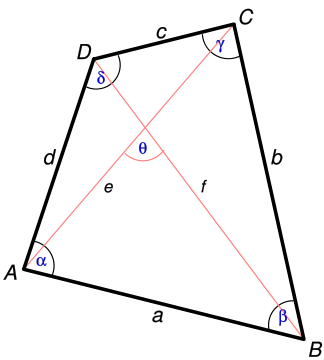Bretschneider's formula - Area of a general quadrilateral
Description
In geometry, Bretschneider’s formula is the shown expression for the area of a general quadrilateral.
A quadrilateral is a polygon with four sides (or edges) and four vertices or corners. The interior angles of a simple (and planar) quadrilateral add up to 360 degrees of arc.
Bretschneider’s formula works on any quadrilateral, whether it is cyclic or not.
The German mathematician Carl Anton Bretschneider discovered the formula in 1842. The formula was also derived in the same year by the German mathematician Karl Georg Christian von Staudt.
Related formulas
Bretschneider’s formula generalizes Brahmagupta’s formula for the area of a cyclic quadrilateral, which in turn generalizes Heron’s formula for the area of a triangle.
The trigonometric adjustment in Bretschneider’s formula for non-cyclicality of the quadrilateral can be rewritten non-trigonometrically in terms of the sides and the diagonals e and f, as shown here:

Variables
| K | area of the quadrilateral (m2) |
| s | semiperimeter (m) |
| a | side a (m) |
| b | side b (m) |
| c | side c (m) |
| d | side d (m) |
| α | angle between sides a and d (degree) |
| γ | angle between sides b and c, opposite to α (degree) |